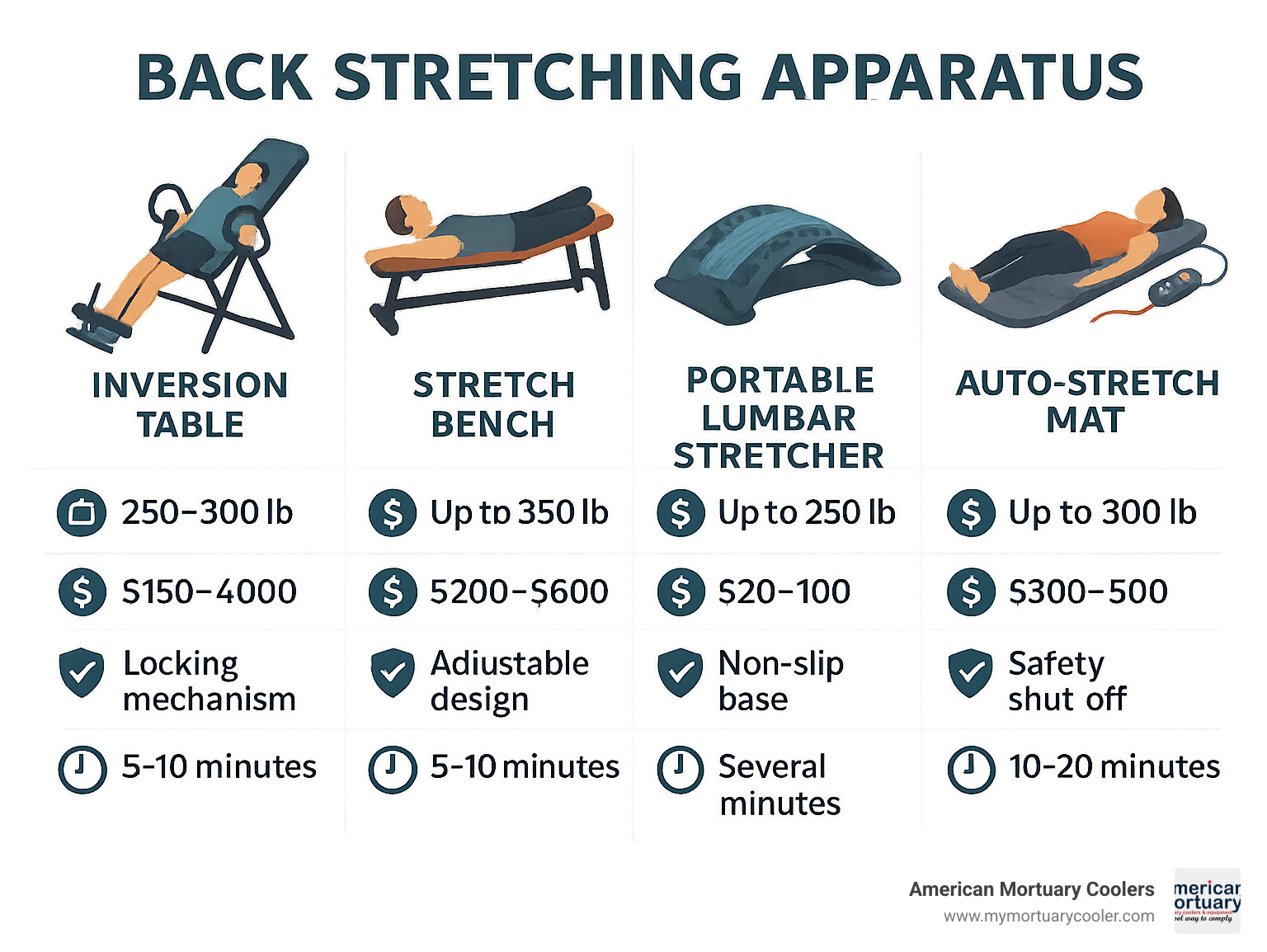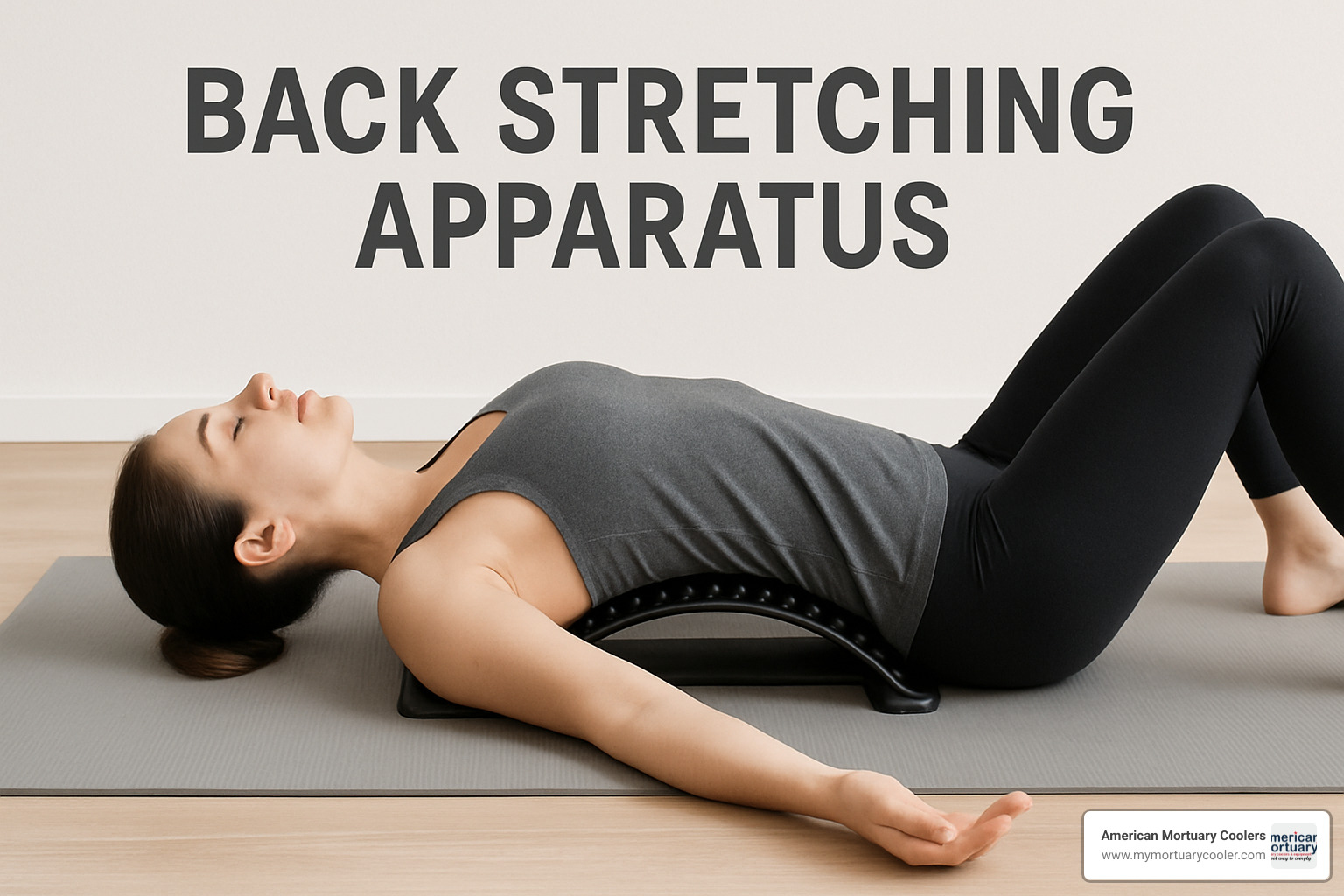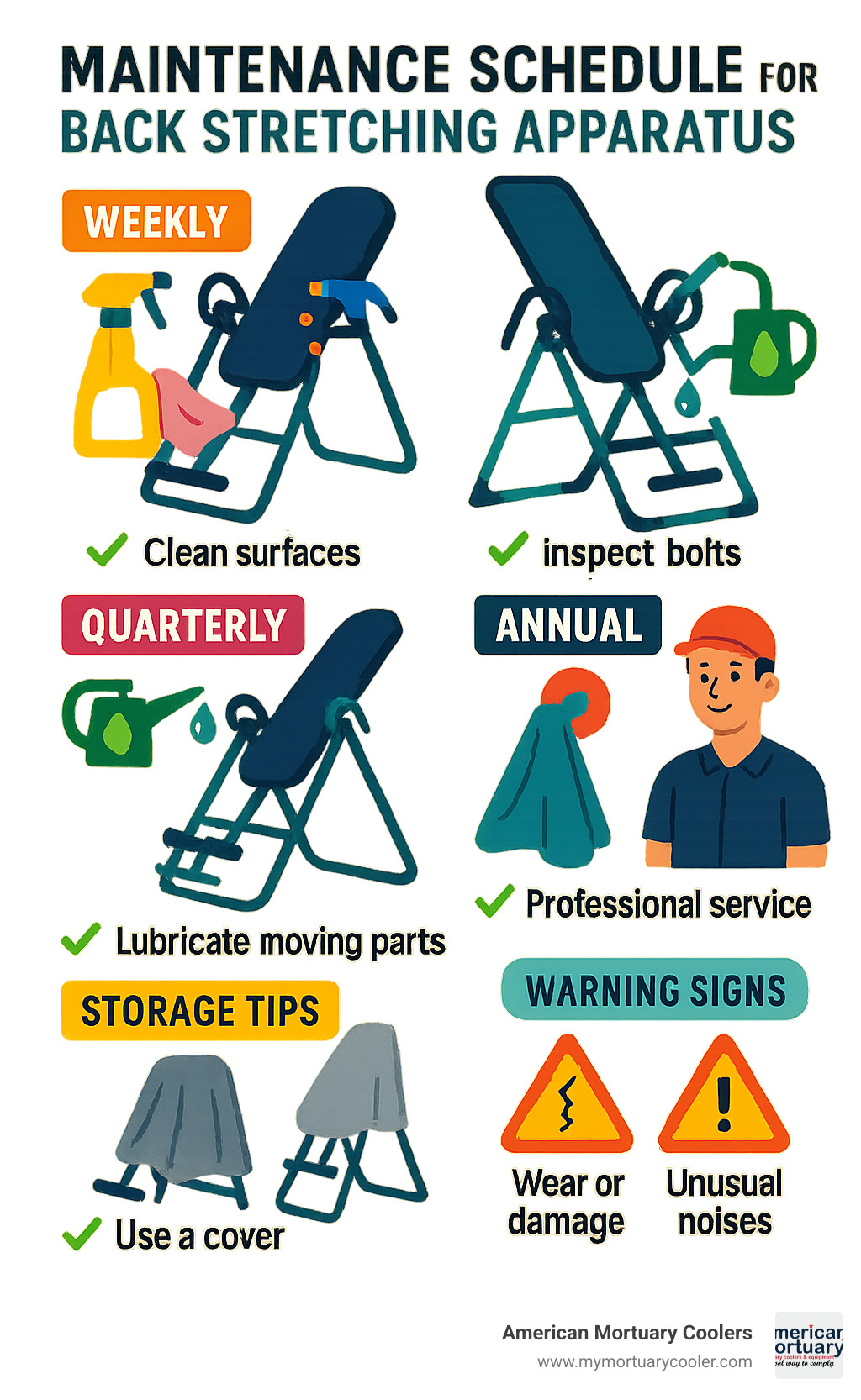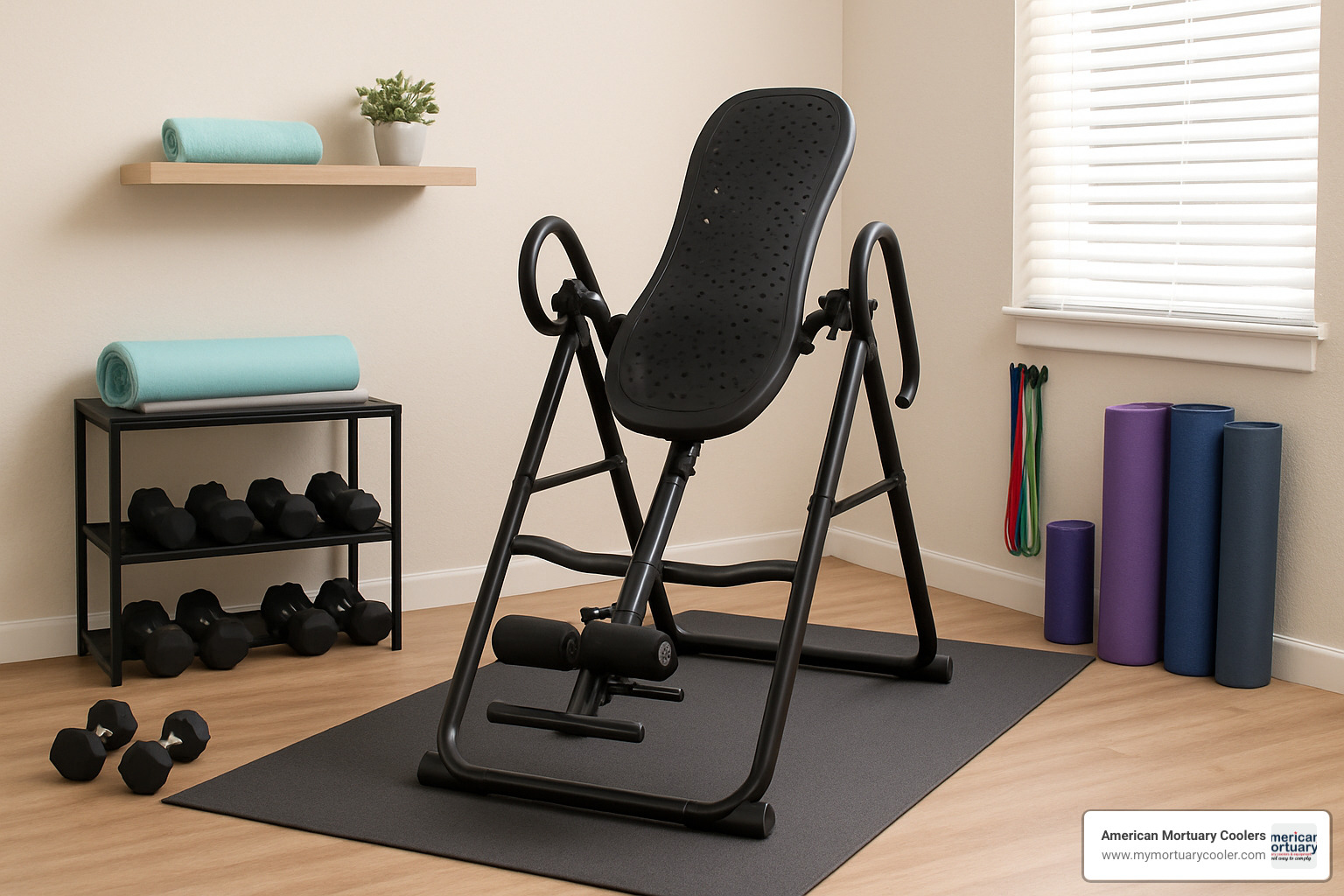
Ultimate Checklist for Choosing the Best Back Stretching Apparatus
Why Back Stretching Apparatus Technology Matters for Your Health
A back stretching apparatus is a specialized device designed to provide spinal decompression and muscle relief through gentle traction, helping reduce back pain and improve posture. These machines work by creating space between vertebrae, relieving pressure on compressed discs and pinched nerves.
Quick Answer - Main Types of Back Stretching Apparatus:
- Inversion Tables - Use gravity and body weight for full spinal decompression ($150-$400)
- Stretch Benches - Horizontal traction without going upside down ($200-$600)
- Portable Lumbar Stretchers - Curved devices targeting lower back ($20-$100)
- Auto-Stretch Mats - Electric devices with heat and massage functions ($300-$500)
Back pain affects millions of people, with research showing that over 80% of adults will experience back problems at some point in their lives. The back treatment industry has grown to $50 billion, with a projected 30% growth over the next twenty years.
Modern back stretching apparatus designs range from simple arched stretchers to sophisticated inversion tables with heat and massage features. Popular models like the Innova Inversion Table have over 42,800 customer reviews with 4.6-star ratings, while devices like the Klug Stretching Massager Ultra offer 3 intensity levels and 7 programs for customized relief.
The key to choosing the right device lies in understanding your specific needs, safety requirements, and budget constraints. Whether you're dealing with herniated discs, sciatica, or general muscle tension, the right apparatus can provide significant relief when used properly.
I'm Mortuary Cooler, a national-level mortuary equipment supplier who understands the importance of reliable, durable equipment that serves specific operational needs. Through years of working with funeral home directors who spend long hours on their feet and need reliable back stretching apparatus solutions, I've gained valuable insights into what makes these devices effective for professional use. This comprehensive guide will help you steer the options and find the best solution for your specific requirements.

Relevant articles related to back stretching apparatus:
What Is a Back Stretching Apparatus & How Does It Work?
Think of a back stretching apparatus as your personal spine relief system. These clever devices use mechanical traction to gently pull your vertebrae apart, creating space where there wasn't any before. It's like giving your compressed discs room to breathe again.
The magic happens through several different approaches. Bodyweight leverage systems use your own weight as the stretching force, while inversion devices literally flip your world upside down to let gravity do the work. Inflatable lumbar supports create targeted pressure points, and electric mats use motors to provide consistent, controlled movement.
What makes these devices so effective is their ability to promote muscle relaxation while reducing nerve pressure. When your back muscles finally get a chance to unwind, the tight knots and spasms that have been plaguing you start to melt away. Meanwhile, decompression takes the squeeze off pinched nerves that might be shooting pain down your legs or up into your shoulders.
Anatomy of Spinal Decompression
Your spine is basically a tower of 24 building blocks called vertebrae, with squishy discs sandwiched between each one. These discs are like jelly donuts - they have a tough outer ring and a gel-like center that acts as your body's shock absorber system.
When life gets heavy (literally and figuratively), these discs get squeezed like a stress ball. Poor posture from hunching over a desk, lifting heavy objects, or just the daily grind of gravity can compress them until they bulge out and press on nearby nerves. That's when the real trouble starts.
The facet joints are the hinges that connect each vertebra, allowing you to bend, twist, and move. When these joints get stiff or inflamed from all that compression, they add their own layer of discomfort to the mix. A quality back stretching apparatus addresses both problems by creating gentle separation throughout your entire spinal column.
Physics Behind Gentle Traction
The science behind spinal decompression is surprisingly straightforward. You need two opposing forces - one pulling up, one pulling down - to create space between compressed vertebrae. It's like a gentle tug-of-war with your spine caught in the middle.
Gravity-based systems are the most common approach. Inversion tables literally turn you upside down so gravity pulls your upper body away from your lower body. The beauty of this system is that it's completely natural - no motors, no complicated mechanisms, just physics at work.
Counter-balance mechanisms work differently but achieve the same result. These devices use adjustable weights or resistance to create horizontal traction, perfect if hanging upside down makes you dizzy or uncomfortable. The adjustable angle feature lets you control exactly how much stretch you're getting, starting gentle and increasing as your body adapts.
The key is consistency and patience. Quick, jerky movements won't help and could actually make things worse. The best results come from steady, gentle pressure applied over several minutes, giving your discs time to decompress and your muscles time to relax.
Comparing the 4 Main Types of Back Stretching Machines
Choosing the right back stretching apparatus can feel overwhelming with so many options available. Think of it like picking the right tool for a job - each type serves a specific purpose and works best for different situations and budgets.
Let me walk you through the four main categories so you can find what works best for your needs.

Inversion Tables
Inversion tables are the rock stars of the back stretching world. They flip you upside down (or partially upside down) and let gravity do the heavy lifting. It's like hanging from monkey bars, but way more comfortable and controlled.
The Innova ITM5900 Advanced Heat and Massage Inversion Table is the crowd favorite with over 14,400 reviews and a solid 4.6-star rating. What makes it special? Built-in heat therapy and massage functions that work while you're inverted. It's like getting a spa treatment while decompressing your spine.
If you want the premium experience, the Teeter EP-560 Ltd. brings serious credentials to the table. This model has FDA registration and UL safety certification, supporting up to 300 pounds. With over 3,200 customer reviews averaging 4.6 stars, it's the choice for people who want the best quality and safety features.
For those just starting out or watching their budget, the Sunny Health & Fitness Full Body Inversion Table offers great value. At 4.5 stars from 305 reviews and over 100 units selling monthly, it proves you don't need to break the bank for effective inversion therapy.
Stretch Benches & Traction Chairs
Not everyone wants to hang upside down - and that's perfectly fine. Stretch benches provide horizontal traction while keeping your feet firmly planted on the ground (or close to it).
The Stamina InLine Back Stretch Bench has earned 961 reviews with a 3.9-star rating, supporting users up to 250 pounds. These devices work by positioning your body on an adjustable frame that creates gentle traction through smart body positioning and leverage.
What's really neat about some models is they include cervical traction capabilities. That means you can work on both your neck and back in the same session. It's like getting two machines in one.
Full-body stretching rigs like the TotalStretch TS100 Commercial model take things to the next level. They offer comprehensive stretching capabilities that go way beyond just back decompression. The trade-off? They need more space and a bigger investment.
Portable Lumbar Stretchers
Sometimes simple is better. Portable lumbar stretchers focus specifically on your lower back - the area that gives most people the most trouble.
The MINOLL Back Stretcher is proof that good things come in small packages. With over 3,600 reviews and a 4.3-star rating, plus more than 2,000 units selling monthly, this little device has won over a lot of backs.
These devices feature an adjustable arch design that follows your spine's natural curve. You'll find them made from different materials - some use firm foam while others use durable plastic. Many include acupressure nodes for extra therapeutic benefits.
The biggest advantage? You can take them anywhere. Use one at home while watching TV, at the office during lunch break, or pack it for travel. At $20-$100, they're also the most wallet-friendly option.
Auto-Stretch & Massage Mats
Welcome to the luxury end of the back stretching apparatus world. Electric stretching mats are like having a personal massage therapist who never gets tired.
The Klug Stretching Massager Ultra represents the cream of the crop. It features effortless auto-stretching with 3 intensity levels, 7 exceptional programs, and 2 levels of heat function - all in a foldable, portable design.
These devices combine mechanical stretching with heat therapy and massage functions. The automated programs take the guesswork out of your routine by providing pre-programmed sessions custom to different conditions and preferences.
Despite all the advanced features, the foldable design makes storage surprisingly convenient. Most models come with remote controls and safety shut-off features, so you can relax knowing the machine will take care of everything safely.
Key Benefits, Risks & Safe Usage Guidelines
Using a back stretching apparatus can transform your daily comfort and mobility, but like any therapeutic device, success depends on understanding both the benefits and potential risks. The good news? Scientific research on spinal traction backs up many of the benefits people experience, while also providing clear guidelines for safe use.
The most immediate benefit most people notice is pain relief. Whether you're dealing with herniated discs, sciatica that shoots down your leg, or just general muscle tension from sitting at a desk all day, these devices can provide significant comfort. Many users report feeling relief within the first few sessions.
Beyond pain relief, regular use often leads to improved posture as your spine realigns and supporting muscles strengthen. Your core muscles naturally activate as your body stabilizes during stretching sessions, which creates a nice bonus workout effect.
The flexibility and blood flow improvements that come with consistent use often surprise people. Better circulation helps your spinal discs stay hydrated and healthy, while increased flexibility makes everyday movements easier. Many users find they sleep better and rely less on pain medications over time.
Perhaps the biggest advantage is the convenience factor. Instead of scheduling and paying for regular clinical visits, you can get relief in your own home whenever you need it.
Pros and Cons of Using a Back Stretching Apparatus
Let's be honest about what you can expect. The benefits are impressive - most people experience immediate pain relief, better spinal alignment, improved flexibility, and reduced muscle tension. Your circulation improves, which helps keep those spinal discs healthy. Plus, it's incredibly cost-effective compared to ongoing clinical treatments, and you can use it on your own schedule.
However, there are potential downsides to consider. Dizziness or lightheadedness is common, especially with inversion tables where you're literally turning your world upside down. Some people experience muscle soreness if they jump in too aggressively at first.
More seriously, certain medical conditions can actually get worse with stretching devices if you're not supposed to use them. There's also a real risk of falls or injury if you don't set up the equipment properly. Some temporary discomfort is normal as your body adjusts, but persistent pain is a red flag.
Step-by-Step: Safely Setting Up Your Back Stretching Apparatus
Think of your first session like learning to drive - you wouldn't hop in a car and immediately hit the highway, right? Start with a gentle warm-up by walking around for a few minutes or doing some basic stretches. Your muscles need to be ready for what's coming.
When setting up your device, stability is everything. Make sure it's on a level surface and won't wobble or slide. Adjust all the settings for your height and weight - this isn't the time to wing it. Start with the gentlest angle or lowest intensity setting, even if you think you can handle more.
Secure all safety straps and locks properly. This might seem obvious, but it's easy to rush through when you're eager to try your new device. For your first few sessions, have someone nearby who can help if needed.
During your session, limit yourself to 1-3 minutes initially. Focus on deep, relaxed breathing rather than fighting the stretching sensation. If you experience pain or dizziness, stop immediately. There's no prize for toughing it out.
The cool-down is just as important as the setup. Return to a neutral position slowly, do some gentle movements to restore normal circulation, and avoid sudden position changes that might make you dizzy.
Who Should Avoid These Machines?
While back stretching apparatus devices help many people, they're not safe for everyone. If you have severe osteoporosis, the traction forces could actually cause fractures. People with glaucoma or other eye conditions should steer clear of inversion therapy because hanging upside down increases pressure in your eyes.
Recent spinal surgery is another major red flag - you need medical clearance before using any stretching device. Pregnancy, especially in later stages, makes most of these machines unsafe due to positioning requirements and circulation concerns.
Other conditions that require caution include severe hypertension, heart conditions, hernias, and acute spinal injuries. The bottom line? Always talk to your healthcare provider before starting any new treatment, especially if you have existing medical conditions.
At American Mortuary Coolers, we understand the importance of equipment that works reliably when you need it most. Just as we provide dependable solutions for funeral industry professionals who spend long hours on their feet, choosing the right back stretching apparatus means finding a device that will serve you safely and effectively for years to come.
Ultimate Buying Checklist: Features, Prices & Top Models
When you're ready to invest in a back stretching apparatus, the choices can feel overwhelming. I've helped countless funeral directors find equipment that stands up to daily professional use, and the same principles apply here: focus on build quality, safety features, and your specific needs.
Weight capacity is your first consideration. Most home devices handle 250-350 pounds comfortably, but don't cut it close. If you're near the limit, step up to a commercial-grade model. Your safety depends on choosing a device that can handle more than your body weight with room to spare.
Height accommodation varies dramatically between models. While most manufacturers claim their devices fit users from 4'8" to 6'6", the reality is more nuanced. If you're particularly tall or short, read user reviews from people with similar builds. The last thing you want is a device that doesn't fit properly.
Angle adjustability determines how gentle or intense your treatment can be. Basic models offer fixed positions, while premium units provide infinite adjustment. This flexibility becomes crucial as you progress from beginner to advanced user.
The heat and massage functions found on higher-end models aren't just luxury features. They genuinely improve therapeutic outcomes by warming muscles before stretching and providing additional pain relief. However, they also increase the price significantly.
Budget considerations span an enormous range. Simple lumbar arches start around $20, while premium motorized systems can exceed $600. The sweet spot for most people falls between $150-$400, where you get solid construction without paying for features you might not need.
User reviews tell the real story about durability and effectiveness. I always recommend looking for models with at least 500 reviews and ratings above 4.0 stars. Pay special attention to negative reviews - they often reveal deal-breaking issues that marketing materials won't mention.
Must-Have Safety & Comfort Features
Safety features separate quality devices from potential hazards. Locking hinges prevent accidental collapse during use - this isn't optional. I've seen too many cheap devices fail at critical moments, and the results aren't pretty.
Quality ankle support systems on inversion tables distribute your weight evenly and prevent dangerous slipping. The ankle cushions should be thick, well-padded, and adjustable to fit your leg size securely. Cheap ankle supports cause discomfort and create safety risks.
Non-slip base materials keep your device stable on various floor surfaces. Whether you're using it on carpet, hardwood, or tile, the base should grip firmly without scratching your floors.
Adequate padding protects pressure points and makes longer sessions comfortable. Thin padding compresses quickly and becomes useless. Look for high-density foam that maintains its shape over time.
Quick-release mechanisms allow rapid return to neutral position if you experience discomfort or dizziness. This feature is especially important for inversion tables, where getting upright quickly can be crucial.
Look for safety certifications from recognized organizations. UL listing indicates electrical safety for powered models, while FDA registration demonstrates additional quality commitment, though it's not legally required.
Budget vs Premium—Where the Money Goes
Understanding where your money goes helps you make smarter purchasing decisions. Entry-level lumbar arches ($20-$50) provide basic spinal decompression through simple curved designs. They're portable, affordable, and effective for mild discomfort.
Mid-range benches and inversion tables ($200-$400) add crucial adjustability, better materials, and improved comfort features. This is where most people find the best value - you get professional-quality results without premium pricing.
Premium motorized systems ($400-$600+) include automated programs, heat therapy, massage functions, and superior build quality. The investment often pays off through durability and improved therapeutic benefits, especially for daily users.
Consider your usage frequency when evaluating cost. If you plan to use your back stretching apparatus daily, premium features and durability justify the higher price. Occasional users might find basic models perfectly adequate.
The build quality difference between budget and premium models becomes apparent over time. Cheap devices develop wobbles, padding compresses, and mechanisms fail. Quality devices maintain their performance for years with proper care.
Maintenance & Care Tips
Proper maintenance extends your device's lifespan and ensures safe operation. Regular cleaning with mild soap and water keeps surfaces hygienic and prevents material degradation. Avoid harsh chemicals that might damage padding or metal finishes.
Lubricate moving parts according to manufacturer recommendations - typically every 3-6 months for frequently used devices. A few drops of appropriate lubricant on hinges and pivot points prevents squeaking and premature wear.
Monthly bolt checks prevent dangerous loosening from regular use. Vibration and movement gradually loosen connections, so tighten all hardware regularly. This five-minute task prevents serious safety issues.
Storage covers protect your investment from dust and moisture when not in use. Even indoor storage exposes devices to humidity and airborne particles that accelerate wear.
Keep spare parts like ankle straps, padding, or safety pins available for quick replacement. Most manufacturers sell replacement parts, but availability decreases over time. Order spares while your model is current.

Frequently Asked Questions about Back Stretching Apparatuses
How long should each stretching session last?
Begin with 1-3 minute sessions and gradually increase to 5-10 minutes as your body adapts. The research shows that frequent short sessions prove more beneficial than infrequent long ones. Most manufacturers recommend maximum session lengths of 10-15 minutes to prevent overuse.
Listen to your body - some people benefit from multiple short sessions daily, while others prefer single longer sessions. Consistency matters more than duration for achieving lasting benefits.
Can children or seniors use these devices?
Age considerations vary by device type and individual health status. Most manufacturers set minimum age requirements around 12-16 years, with adult supervision recommended for younger users. Weight and height minimums also apply.
Seniors can often use these devices safely, but medical clearance becomes more important due to increased likelihood of contraindicated conditions. Start with gentler devices like lumbar stretchers before progressing to inversion tables.
What non-equipment alternatives exist for spinal decompression?
Manual therapy from qualified professionals offers personalized treatment. Physical therapy exercises target specific muscle imbalances contributing to back pain. Yoga and stretching routines provide gentle spinal mobilization.
Swimming and water therapy reduce gravitational load on the spine. Proper ergonomics at work and home prevent further compression. However, these alternatives often require more time, ongoing costs, or may not provide the consistent traction that a quality back stretching apparatus delivers.
Conclusion
Finding the perfect back stretching apparatus doesn't have to feel overwhelming when you know what to look for. Your specific needs, medical history, and budget will guide you toward the right choice - whether that's a simple $20 lumbar stretcher or a premium $600 motorized system.
Durability and safety should always come first, even if it means spending a bit more upfront. A well-built device with proper certifications and hundreds of positive reviews will serve you faithfully for years, while a cheap knockoff might leave you injured or disappointed after just a few uses.
Here at American Mortuary Coolers, we've spent years understanding what makes equipment truly reliable. Just like we craft custom mortuary solutions that funeral directors can count on day after day, your back stretching device needs to be built to last. We deliver our custom coolers directly across all 48 contiguous states because we know that quality equipment shouldn't be a luxury - it should be dependable.
Whether you're dealing with the occupational hazards of spending long hours on your feet in demanding work environments, or you're simply looking to take better care of your spine before problems develop, the right back stretching apparatus can genuinely transform your daily comfort level.

Don't rush this decision. Talk to your doctor if you have any health concerns, read those customer reviews carefully, and think about how you'll actually use the device in your daily routine. Your spine has been supporting you your whole life - it deserves equipment that will support it properly in return.
The investment you make today in quality spinal care equipment will pay dividends in comfort, mobility, and overall well-being for years to come.



